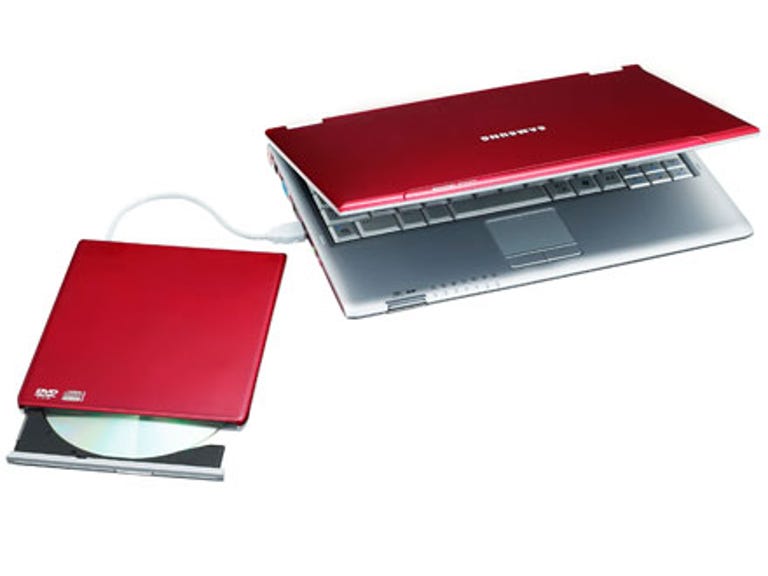 Why You Can Trust CNET
Why You Can Trust CNET Samsung Q30 Plus review: Samsung Q30 Plus
The Samsung Q30 Plus's superb battery life and light chassis make it a highly attractive ultra-portable, despite questionable performance scores.
Design
Less than two weeks back we were admiring the incredibly light-weight Sony VAIO VGN-TX27GP notebook, which comes in at a feather-light 1.25kg. We labelled it "among the lightest notebooks we've tested", but little did we know that we'd soon be feasting our eyes on the 1.1kg Samsung Q30 Plus. This looks highly impressive on paper, but if you dig a little deeper it's unclear which of the two notebooks rank higher in the portability stakes.
The Good
The Bad
The Bottom Line
Despite the Q30's lighter body, its dimensions are still larger than the Sony offering at 287.7mm by 197.5mm by 23.8mm (the TX27 measures 272mm by 195.1mm by 28.5mm). Another factor to consider is that while the TX27 boasts an internal optical drive -- which obviously adds to its weight -- the Q30 bundles an external DVD writer that connects to the device via a Firewire port. This not only consumes a Firewire port that could be used for other devices, but it also adds unnecessary bulk to your backpack. On the flip side, one advantage of the external drive is that you can just as easily leave it at home, since it's rare that you'll need to access a disc whilst on the road.
It's even more arduous to determine which of the two notebooks is more attractive, since each offers a distinct look that suits certain personality types. The Sony TX27 boasts a metallic, professional design, while the Q30 is somewhat more playful with its lipstick-red facade and silver interior.
In terms of durability, the TX27's carbon fibre chassis wins hands down. The Q30 is far from flimsy, but its plastic chassis is fairly soft and it wouldn't take much to dent it. Considering that this is an ultra-portable notebook, we would've preferred a sturdier build quality.
Whilst on the subject of qualms, the Q30's track pad is unusually small, so you'll have to turn up the sensitivity of the mouse pointer or you'll find yourself continually hitting the edges.
Conversely, the keyboard is larger than that seen on most ultra-portables. The function keys are tiny, but the letter keys are all full-size, so bashing out lengthy documents isn't an issue.
Features
Screen quality is a huge factor in our notebook reviews, as there's nothing worse than a dull, low resolution display. The 12.1-inch, 1024x768 unit built into the Q30 impressed us -- it's sufficiently bright and there's enough desktop space for some degree of multitasking. It uses a widescreen aspect ratio, and is compact enough for use on an economy-class plane tray table.
Internally, as with most ultra-portables, the Q30 doesn't offer a great deal of grunt; battery life, not performance, is the key consideration here. It's got an Intel "Ultra Low Voltage" Pentium M 1.2GHz processor, 512MB of DDR memory and a 60GB hard drive, which won't win it any performance awards. But we'll get on to that in the "Performance" section of this review.
All of the necessary networking options make an appearance, including 802.11a/b/g Wi-Fi, 10/100 Ethernet, Bluetooth and a regular 56Kbps modem port. We weren't as impressed with the overall port layout, however, which aside from the ports already mentioned includes two USB 2.0, one Firewire, a VGA output and headphone/microphone jacks. A couple more USB ports and an S-Video port would go down nicely on this notebook.
Budding photographers will be pleased to hear that the Q30 includes a front-mounted card reader, which offers support for the SD, Memory Stick and Compact Flash card formats.
Card reader aside, the Q30's multimedia feature-set is quite sparse. Unlike Sony's TX27, there's no instant-on feature or multimedia quick-launch buttons. For some these are little more than vacuous gimmicks, but we've found them useful for frequent DVD playback.
Performance
We focus our notebook performance tests around general qualitative use and the quantitative MobileMark 2005 benchmark. MobileMark's office productivity performance rating didn't flatter the Q30; its score of 73 was just behind the TX27, but another competing ultra-portable, the Acer TravelMate 3010 left it in its dust. This is undoubtedly due to the modest selection of internal components, which were chosen to keep power consumption low and battery life high.
BAPCo MobileMark2005 performance rating
(Longer bars indicate better performance)
Our own qualitative tests didn't paint as dire a picture. We found that the Q30 completes most basic tasks, such as word processing and DVD playback, without noticeable delays. Multi-tasking sees performance drop off somewhat, but as long as you're not attempting to run games or audio/video editing software on the machine, you shouldn't be too peeved by its performance.
Battery life is a different kettle of fish altogether, with the Samsung notebook trumping both the Sony and Acer offerings. We found that it lasted over 5.5 hours on a single charge whilst under constant, general use. Intermittent use throughout the day should allow you to get through an entire working day without touching a power plug.
BAPCo MobileMark2005 battery life rating
(Longer bars indicate more battery-life minutes)
For emergencies, Samsung also includes an additional, smaller battery, which can be used when the main battery dies. This will add around 90 minutes of extra battery life onto the scores provided in the graphs above.
Our overall impressions of the Samsung Q30 Plus are highly positive. We didn't like it as much as the Sony VAIO VGN-TX27GP, but its superb battery life and great portability should make it an instant hit amongst those looking for an ultra-portable notebook.
